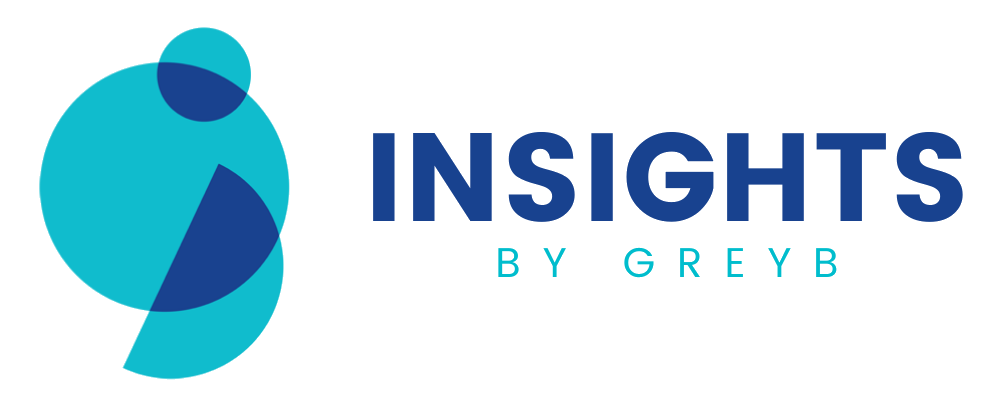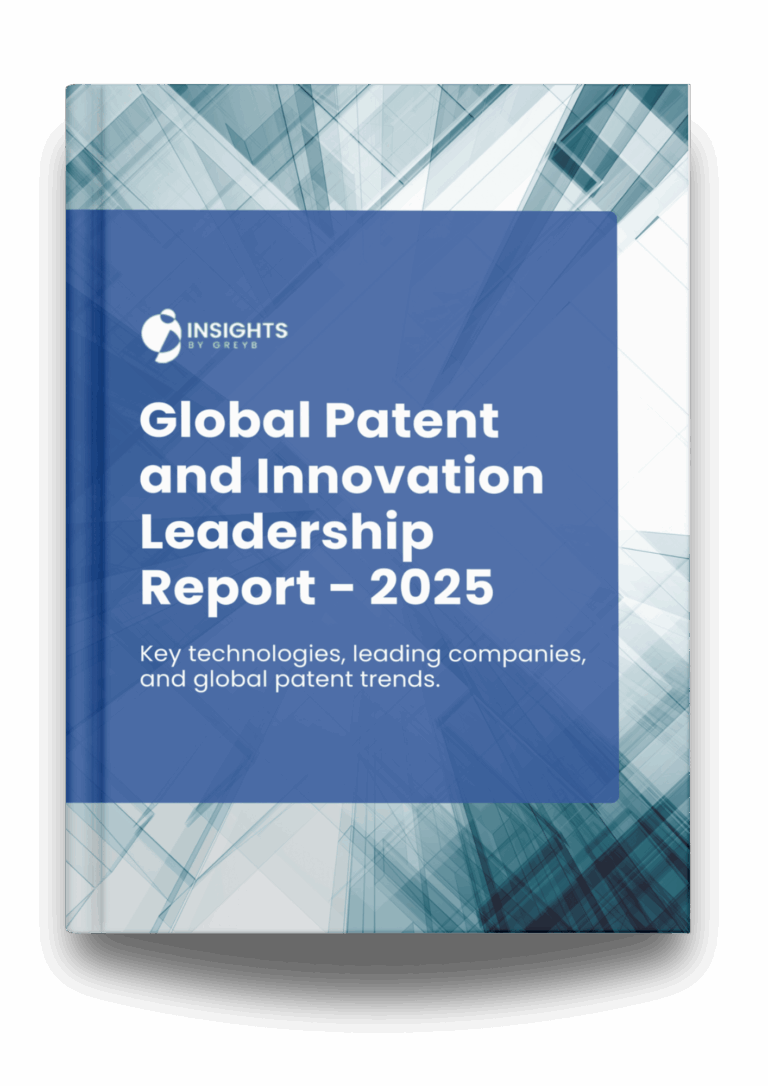Argo AI develops sensors, software, cloud infrastructure, and high-definition maps for autonomous vehicles. The start-up was established in 2016 in Pennsylvania by Brian Salesky (previously director of hardware development at Waymo) and Peter Rander (previously engineering lead at Uber ATG).
In 2017, within 6 months of its inception, Ford Motors invested $1bn in Argo AI and acquired a majority stake.
“The AV journey will be a long one, but Ford is now well-positioned to run this race and compete like few others can,”
~ Ford CEO Jim Hackett
In 2020, Volkswagon Group invested US$ 2.6 billion in Argo AI. The deal expanded Argo’s operations in Europe as well its workforce as VW Groups’ subsidiary Autonomous Intelligent Driving (AID) get absorbed into Argo AI. You can read Ford’s take on the VW investment here. The startup was valued at US$ 7.5 bn after the deal.
Argo aims at producing SAE Level 4 self-driving systems for Ford by 2021. VW aims to launch its self-driving electric minivan ID Buzz for ride-hailing service in 2025. ID Buzz will be the first VW vehicle to use Argo AI’s AV technology.
An Overview of Argo AI Patents
Brain Salesky believes that self-driving technology is ripe for many applications and new businesses can be built on it. He sees long-haul autonomous trucking, e-commerce deliveries, commuting in cities, and mining as application areas for Argo’s technology.
It seems that at present Argo’s R&D is focused on developing sensors for SLAM and trajectory planning. The majority of patents in Argo AI’s patent portfolio are on Lidar. There are only “7” patents that are focused on autonomous driving, and there is no patent on car-pooling or other such applications of self-driving technology.
This can be understood very well from the business plan of Argo AI. The start-up doesn’t aim to build its own mobility services. It aims to get paid based on the number of miles clocked by a self-driving car using its SDS technology.
Argo also acquired Princenton Lightwave back in 2017. The acquisition put it into a sweet spot where it can innovate in both sensor hardware and sensor interface and can achieve performance improvements that otherwise weren’t possible
“We are constantly exploring how to increase the range, resolution, and field of view of Lidar, but we’re also looking to lower costs and manufacture these sensors at scale. By collaborating with our in-house hardware and software developers, as well as our supply base, we will work to create lidar sensors that not only meet the demanding performance required for high-volume production but also are affordable.”
~ Brain Salesky
In the patent portfolio of Argo AI, there are 119 patents that belong to 62 unique patent families. The below exhibits highlight the key statistics of Argo AI’s patent portfolio.
Legal Status (Alive/Dead)
The exhibits below distribute Argo AI’s patents into active and inactive categories which are further divided into total, application, and granted parts. Among 72/119 active patents in their entire portfolio, 33 are granted patents and 39 are pending applications. Of the 47 dead patents, 32 are patent applications and 15 are granted patents.
Worldwide Patents
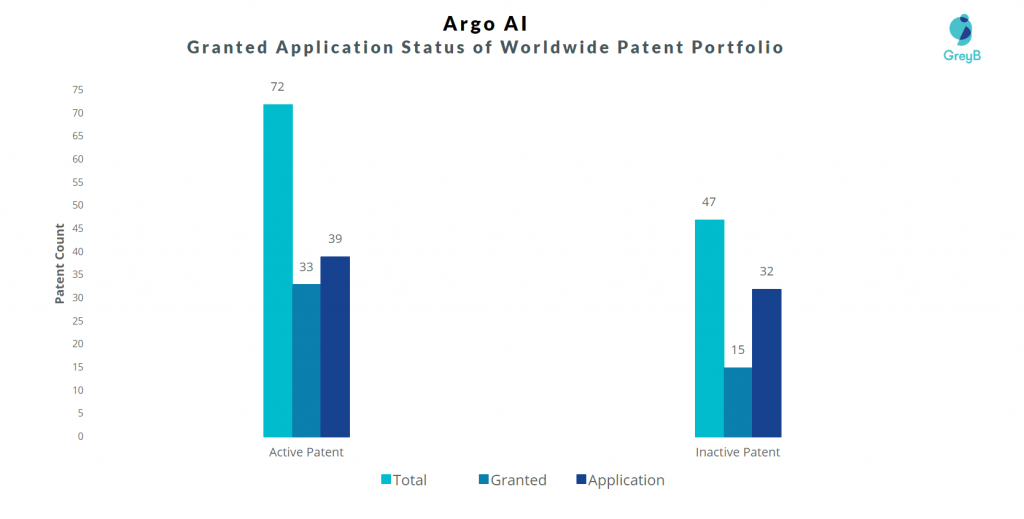
Patent Families
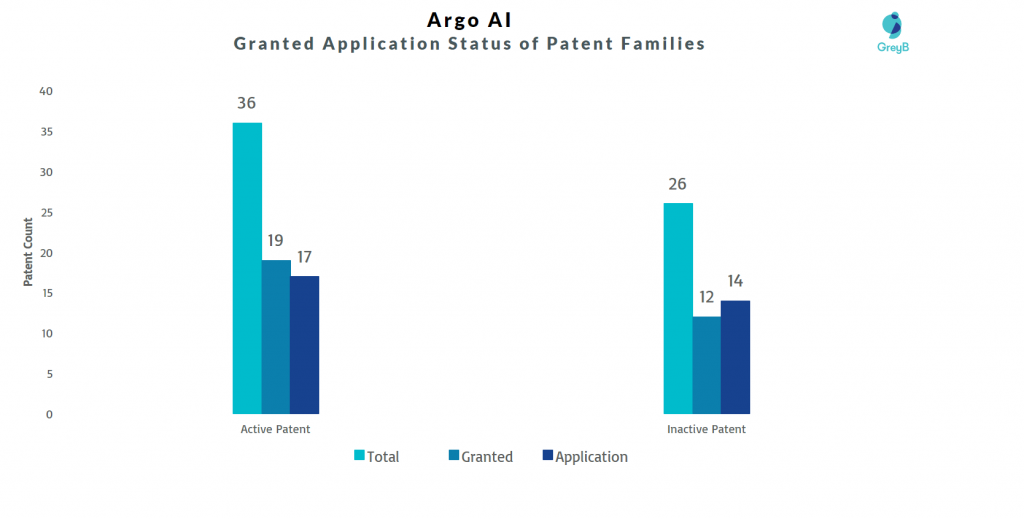
Filing Trend of Argo AI’s Patents
The patents filed before 2016 (founding year), majorly belong to Princeton Lightwave which was acquired in 2017. This acquisition was aimed at the development of Level 4 & Level 5 virtual driving systems as Princeton Lightwave has expertise in LiDAR technologies.
We have included all the family members to plot the filing trend. A patent family can have multiple patent documents – filed globally or in a single country – covering a single invention.
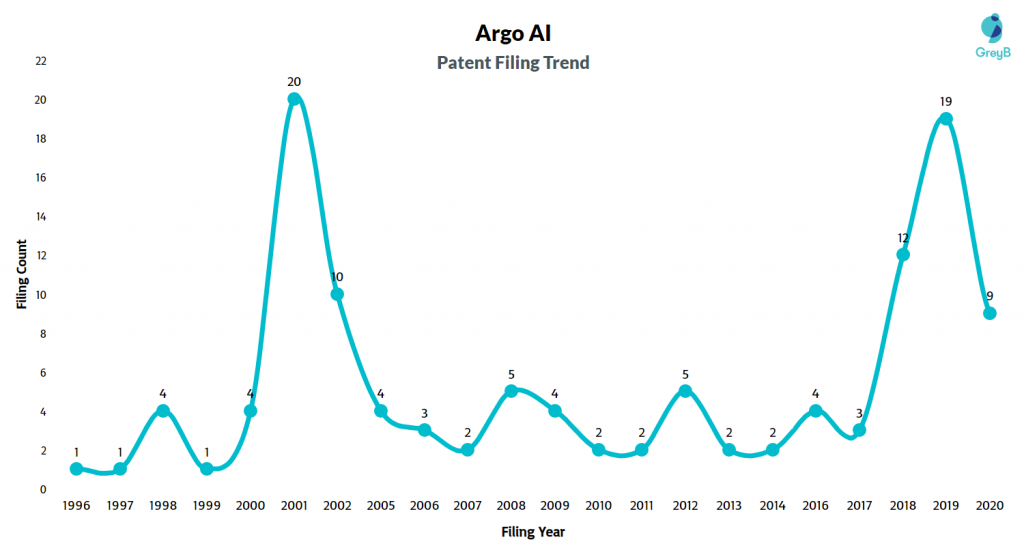
From the exhibit below, we can see that how has patent priority trend of Argo AI with timeline. Here we have included one patent per family to plot the exhibit.
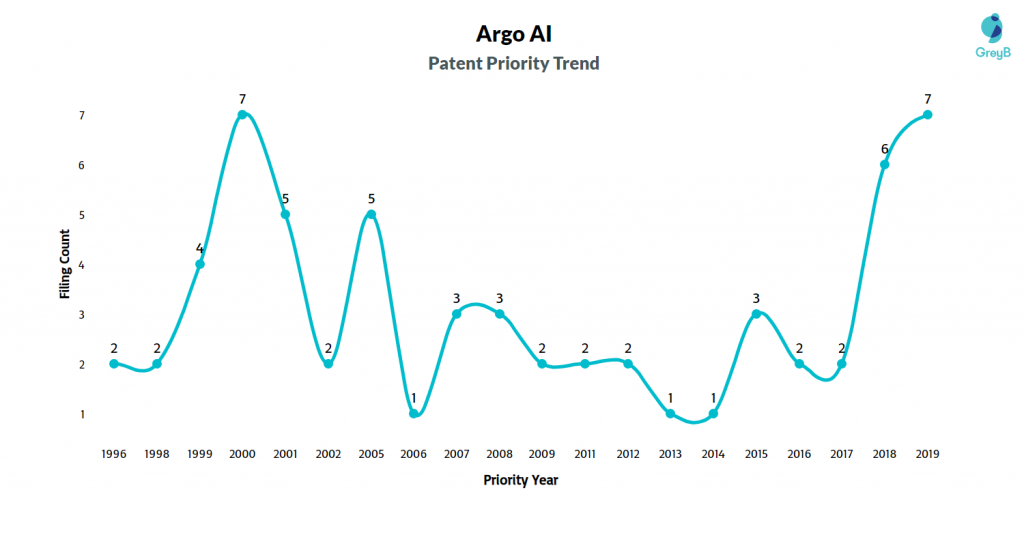
Country Wise distribution of Argo AI Patents
This chart shows that how has Argo AI filed patents over the world and the United States of America is on the top of the list. The exhibit below doesn’t include 25 patents applications filed with WIPO and EPO.
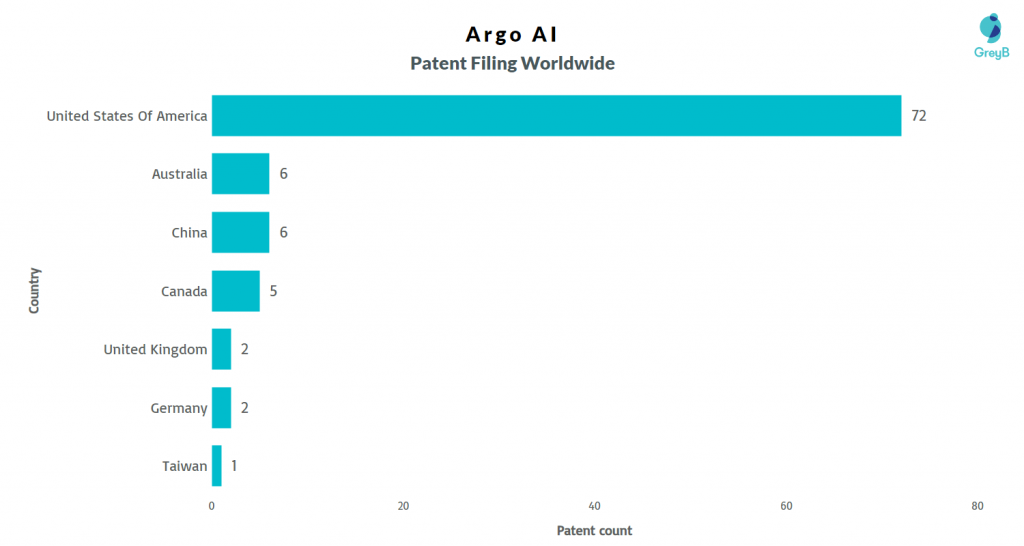
Research Centers of Argo AI
The exhibit below is plotted by considering the country where an invention in a patent family was introduced for the first time. In turn, this helps find the R&D centers across the globe and lets us peek into the kind of research going on in a particular country. In the case of Argo, it is clearly evident that the USA is where its R&D engine is revving.
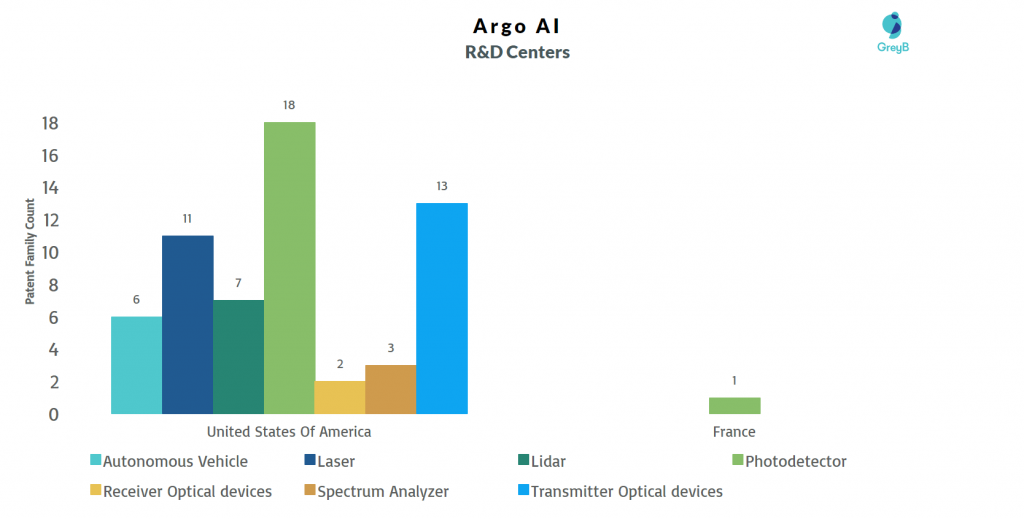
The exhibit below distributes patents filed by Argo in different countries on the basis of the technology protected. It also represents the markets where Argo AI thinks it’s important to protect particular technology inventions.
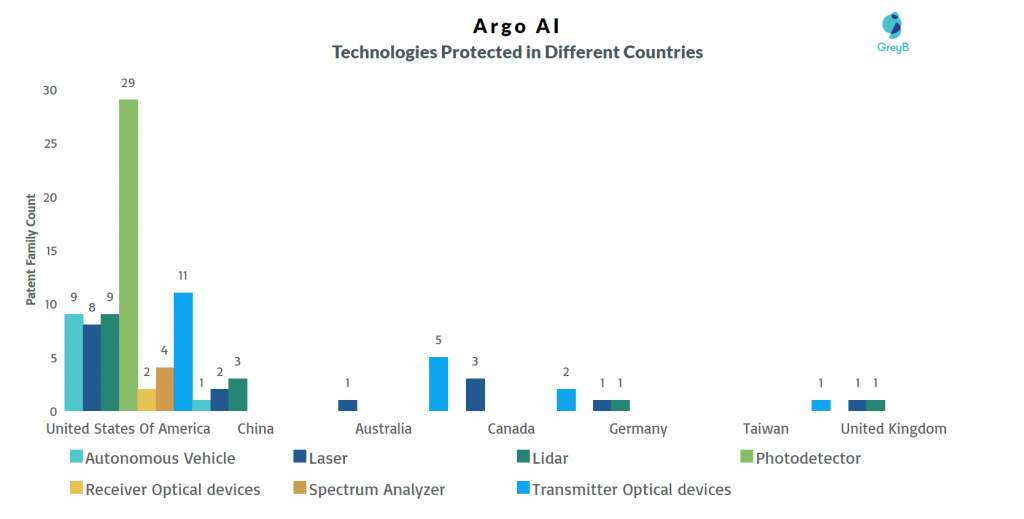
R&D Direction Over the Years
This exhibit below shares how the research focus of Argo AI changed over the years. Throughout the timelines, their patents have mostly focused around laser-based optical devices with autonomous vehicles dominating in past few years.
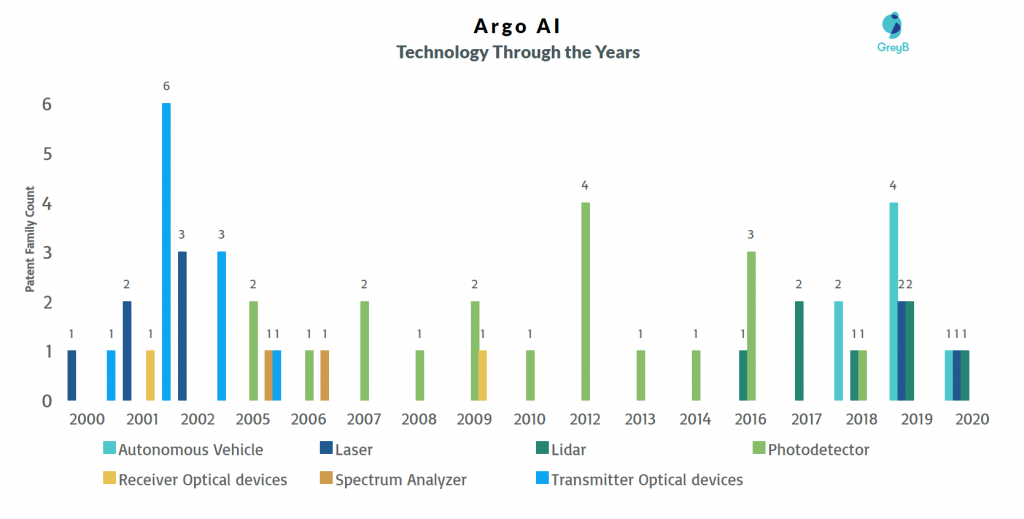
Technological Profile of Argo AI Patent Portfolio
Argo AI’s patents are distributed into seven categories– in the exhibit below. 88% of Argo’s patent portfolio is focused on Lidar and its constituent devices. Only 7 patent families disclose inventions on Autonomous vehicles. Sections below offer brief details of each tech cluster.
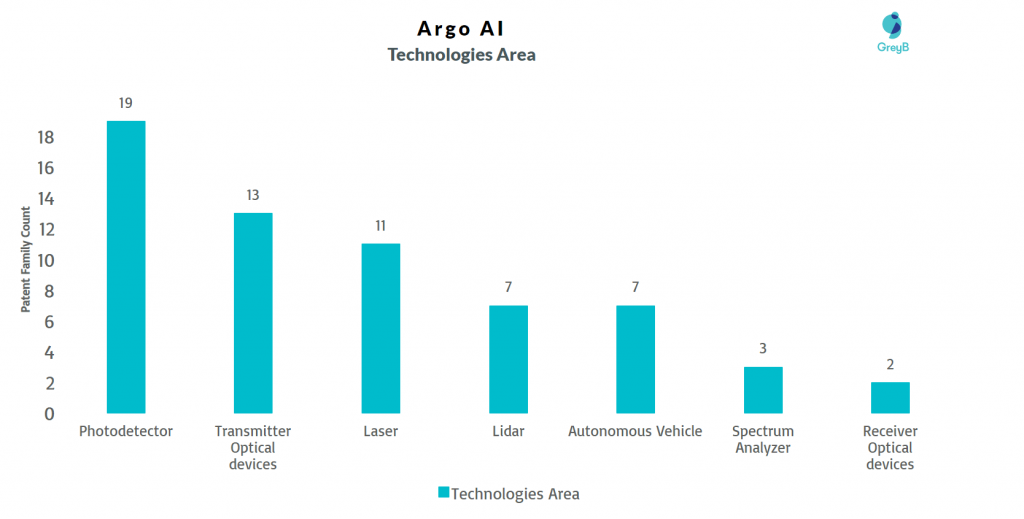
Argo AI Patent Portfolio: Photodetectors
Photodetectors are p-n junction diodes that sense light radiation and produce a current in response. This section of the portfolio consists of 19 unique patent families. The majority of patents here deal with avalanche photodiodes which are becoming an essential element in driver assistance systems due to their high precision.
Exemplary Patent: Patent US9851556B2 talks about GmAPDs (Gieger-mode Avalanche Photodiodes) which are useful in single-photon imaging systems. This means that the photodiode can be triggered by a single photon to produce a digital pulse. However, GmAPDs have limited pixel formats which can be solved by scaling to larger pixels. This can lead to the high costs and technological complexities. The patent provides a method for improving the field of view of GmAPDs using an array of movable mirrors. This essentially means more pixels without actually scaling to larger pixels.
Argo AI Patent Portfolio: Transmitter Optical Devices
The domain consists of 13 unique patent families. The patents in this section initially belonged to Princeton Lightwave and talk about use of optoelectronic devices for transmission purposes. The patents here talk about polarization, amplification of optical signals, use of super-luminescent diodes, and the like.
Exemplary Patent: Lighting arrangements are used for illumination of products like foodstuffs, plastics etc. for spectroscopic inspections. However, such systems generally have poor intensity, poor directionality and are not cost effective. Patent US7437035B2 provides a system for improving illumination systems using optical wave guides. The system helps in distribution of light over a particular rectangular region with a predetermined power density.
Argo AI Patent Portfolio: Lasers
Argo has 10 unique patent families covering Lasers. Majority of these patents belonged to Princeton Lightwave and Trumpf Photonics. The patents in the cluster cover inventions on high-power superluminescent diodes, frequency-selective mirrors, closed-loop ring resonator, monolithic semiconductor laser arrays, and methods and way to fabricate and improve lasers.
Exemplary Patent – When the size of laser diode array increases, total current required by the system also increases since they are generally connected in parallel combination. This can lead to complexities in the system in the form of associated cables and supplies making its practical deployment difficult like in LiDARs. This can be solved by using series combination of laser diodes which poses challenges in manufacturing. Patent CN110943369A provides an arrangement for using multiple laser diode arrays in series using monolithic series connected laser diodes. The patent discusses a manufacturing technique for same as well.
Argo AI Patent Portfolio: LiDAR
Argo’s 7 patent families on LiDAR discuss methods of sensor fusion, single-photon detector LiDAR, methods to get a high SNR, and other improvements in LiDAR systems.
Exemplary Patent: LiDAR systems are used for mapping the surroundings of autonomous vehicles. Sometimes in order to reduce the optical power required for mapping, LiDAR systems use Geiger mode avalanche photodiodes (Gm-APDs) in receiver systems. In Geiger mode, photodiode is armed at voltage higher than breakdown voltage. However, these Gm-APDs have high noise when range of mapping increases. Patent US10386487B1 discusses a method to reduce noise in such systems. The system uses signal sampling in such a way that longer range regions are sampled more time than shorter range regions. This can lead to better and improved detection.
Argo AI Patent Portfolio: Autonomous Vehicles
The domain consists of 7 unique patent families. The patents talk about the management of various vehicle sub systems. The mentioned sub systems are responsible for thermal management of vehicle sensors, ride comfort, monitoring systems. Also, one invention in the cluster discusses the use of recurrent neural networks for forecasting vehicle trajectories.
Exemplary Patent: Different riders have different ride preferences when traveling in an automobile. For instance, some riders prefer speed over comfort and vice-versa. Hence, personalized ride experiences may be required for riders. Patent US20200148195A1 provides a solution where different comfort configurations for a vehicle can be selected by a rider. Set of instructions linked to each configuration will be passed to vehicle control systems thereby controlling the operation of the autonomous vehicles like steering, braking, etc.
Argo AI Patent Portfolio: Spectrum Analyser
Spectrum Analyser is a device that is used to analyze signal amplitude with respect to frequency. In optical telecommunication systems, spectral analysis is performed to ensure that signals are within their intended operating parameters. There are 3 patent families dedicated to spectrum analyzers. The patents discuss optical spectrum analyzer (which cover optical power as a function of wavelength), systems for confocal mapping of tissues, etc.
| Publication Number | Priority Date | Title |
| US6452681B1 | 1999 | Optical spectrum analyzer |
| US7251028B2 | 2005 | Scanning spectrum analyzer |
| US7366365B2 | 2005 | Tissue scanning apparatus and method |
Argo AI Patent Portfolio: Receiver Optical Devices
The domain consists of 2 patent families.
- US20100193412A1 discusses a device for splitting a reflected beam into visible spectrum and near-infrared spectrum which can be used in a scanning system as objects show different characteristics when viewed under different wavelengths. The invention can be particularly useful in optical sorting machines in the food and pharma industries. The device uses two transparent prisms between which are sandwiched indium tin oxide (ITO) which acts as a light splitting material.
- US6909826B2 discusses an optical monitor based on Bragg gratings ( A Bragg grating is a transparent device that has a periodic variation in its refractive index). The use of Bragg gratings can help in improving the resolution and performance of the monitoring devices.
